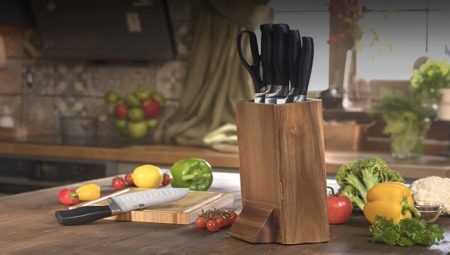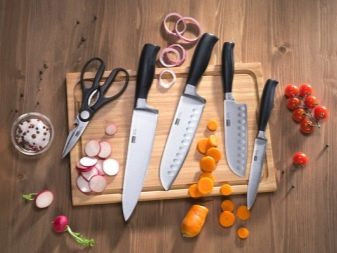Berndes knives overview

A knife is a must-have in any kitchen. The comfort and speed of cooking depends on how convenient and spicy it is, as well as the mood of the hostess. Among a large number of brands and models, German manufacturers, including Berndes and their stainless steel products, have been highly valued for decades.

Features of steel
Before the advent of stainless steel in the early 19th century, knives and other household items were made primarily of iron. But this material is very unstable to various external factors and, for example, is easily covered with rust if the surface has not had time to dry. At the same time, it becomes stained very quickly, acquiring a not very pleasant appearance.
As an alternative, ceramic knives were sometimes used (and are still used), but they are significantly inferior to metal knives in strength. Therefore, the new steel alloy turned out to be a real find and has not lost its popularity to this day, because all of the listed disadvantages are unusual for it.
Berndes knives from Germany are 3Cr13 steel, the composition of which has been specially selected for this kind of products. It is flexible and highly durable (even when compared to other grades of stainless steel). To maintain the quality, an appropriate standard is applied, which regulates the precise chemical composition and properties of the steel.


Varieties
Universal
This is a standard knife, which is called universal or multifunctional for a reason. It can be used for any culinary experiment, it can replace the missing specialized knife. For too large products, it will be less convenient due to its small size., but great for vegetables, fruits, bread, butter and more. Its straight blade is particularly good at chop medium-hard vegetables.
With proper care, this model, like the others at Berndes, retains the sharpness of the blade for up to several months. These are quite hard and durable knives, which, among other things, can easily withstand high temperatures, which is important in kitchen affairs. In addition, they are resistant to household acids and alkalis.

Standard chef's
The dimensions of the chef's model may seem unsuitable for cutting into thin slices, but this is not the case. Traditionally, these knives are used for different types of meat, but a chef's knife is also great for cutting vegetables. For example, it is very convenient for them to cut cabbage, large peppers, etc., so it is worth purchasing it in your collection if you often cook soups or vegetable stews.


Santoku
The original solution of Japanese engineers in the form of round grooves along the entire length of the blade is not just a design trick. They prevent the cut food from sticking to the knife. This is especially true when you have to cut something sticky, such as cheese or raw vegetables. Besides, the blade begins to bend closer to the tip, which eases the load on the hand when cutting.

Small japanese knife
The small Japanese santoku has all the same characteristics as its large cousin. The difference lies in the width of the blade, the length of the tip (it is more rounded), and also in the size of the handle. In the event that the holders of large knives turn out to be too thick and inconvenient, you can use this model - it is not inferior in characteristics to them. And despite the small size, This handle is made of impact and heat resistant ABS plastic.
The model is also convenient to use for cutting fish.


Reviews
Most often in the reviews, a comfortable handle is noted, which holds firmly and does not slip in the hand. Its anatomical shape adds comfort to use, and its sharp blade makes the cutting process stress-free. Its acuteness was tested by customers not only on products, but also, for example, on paper, and the knives coped with this perfectly.
Sometimes a marriage is noted in the form of an uneven edge of the blade. Complaints may also apply to santoku knives due to their tips, which do not taper like most knives. But here it is worth considering the fact that these models are designed for cutting not with the tip, but with the base of the blade.
There is also a lack of a stand for knives, which would allow them to be stored in a block - Berndes models are sold only separately.


For an overview of the Berndes chef's knife, see the next video.








